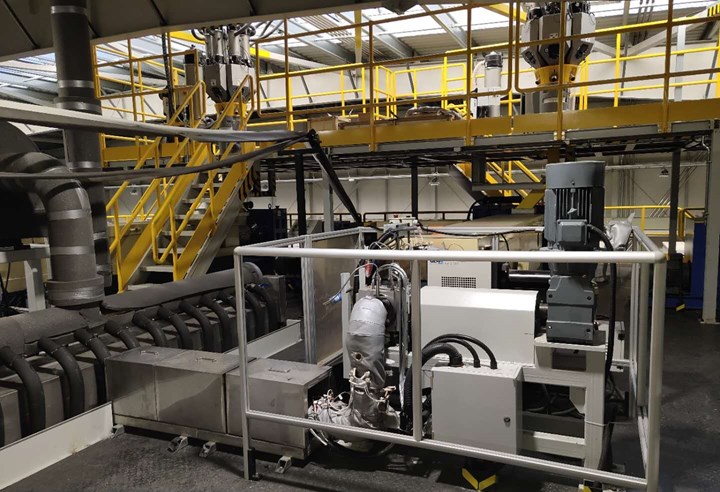Processors producing melt-blown nonwovens for face masks are finding that pumps provide needed precision and efficiency in the extrusion process.
Courtesy of Plastics Technology
By: Jim Callari, Editorial Director at Plastics Technology
With the increased worldwide need for face masks, processors making nonwovens by the so-called meltblown processing method are finding that melt pumps are a critical factor in meeting the technical process requirements and ensuring consistently high-quality fabric.
Nonwovens are much in demand for making face masks in response to the novel coronavirus. That’s because such fabrics, which can comprise hundreds of layers, have excellent filtering properties, notes Wolfgang Martin, sales team leader for Pumps & Filtration at MAAG Group. But the formed fabric alone is not enough to stop the smallest particles. Four physical mechanisms, he explains, also come into play: Screening, inertia, diffusion, and electrostatic charge ensure that even microscopic viruses cannot penetrate through a mask, Martin explains.
Polyolefins—notably PP— are primary the raw material for these high-tech fabrics. In the melt-blown process, Martin says, polymer melt from the extruder is discharged through a nozzle with several hundred orifices. A stream of hot gas below the nozzle tip stretches the continuous filaments, which are then deposited on an air-permeable conveyor belt. Since they are not yet completely cooled at this point, the filaments stick to each other and form a fabric.
 Nonwoven production line at MAAG customer Nanhai Nanxin Wufangbu in China.
Nonwoven production line at MAAG customer Nanhai Nanxin Wufangbu in China.
Martin notes that the fibers produced in the meltblown process require special care and a high level of plastics processing know-how because they are extremely fine--typically just one micrometer (micron) in diameter. By comparison, an average human hair is about 50 to 80 micrometers thick.
How Melt Pumps Fit in
Production of such extremely fine fibers is complex, Martin says. It requires precise coordination of process parameters such as the nozzle geometry, hot-air flow rate, and melt temperature. Melt pressure is particularly important, he points out. The thinner the extruded fabric is intended to be, the higher the pressure. And it must also correlate with a precisely metered feed rate.
According to Martin, this makes melt pumps a key component in meeting the technical process requirements and ensuring that the nonwoven fabric is consistently high in quality. Melt pumps provide a defined volume flow rate with a high degree of accuracy, he elaborates, and ensure the consistently high performance and optimum efficiency required in continuous operation, he explains. Depending on the size of the extrusion line, the number of layers or the materials used, several melt pumps are usually run in parallel.
Another advantage of using the pump, Martin points out, is that the required pressure does not have to be built up inside the extruder, which reduces melt temperature, improves energy efficiency, and results in an extrusion process that’s more gentle on the material. He explains that the viscosity of polymers extremely sensitive to shearing can drop so much when they are heated that they become too liquid for optimum extrusion. In the pump, however, the material is only briefly stressed and is subject to very little shearing.
The gear pump, in particular, allows transfer, pressure boosting and dosing at high pressure and with low shear stress. The result is a consistent feed rate at absolutely constant pressure. In other words, the conditions upstream of the tool are always exactly the same, he states.
MAAG Group’s newly developed models of the extrex6 series are particularly well suited to the production of nonwovens for face masks, Martin maintains. Depending on the viscosity of the resin, these pumps guarantee a tolerance range of 0.02 bar (0.29 psi) pressure variation. This performance is based particularly on the MAAG gear toothing and the special geometry of the gears, according to Martin.
One Processor’s Experience
Chinese nonwoven manufacturer Nanhai Nanxin Wufangbu is one processor that has experienced what this means in a real-world production environment: It has recorded a specific flow rate 10% higher than with comparable pumps. At the same time, it has seen that the temperature rise through the pump is 40% lower, and pulsations at the pump discharge are minimized. Energy saving is 12%. Other advantages in terms of high uptime availability and low operating cost result from the virtually maintenance-free design. This ensures high process stability on the production line at all times.
MAAG’s extrex6 melt pump has found a niche in extrusion lines producing meltblown fabric for face masks.
In the entrex6, the interface between the driving shaft and the pump cover is sealed by what MAAG calls a Viscoseal. Says Martin, “In the lower-cost version with liquid cooling, the relevant area is cooled with water in such a way that the melt becomes more viscous at this point. That way, it can no longer escape and is returned to the pump interior via the return thread of the Viscoseal. This sealing method guarantees trouble-free operation even with low-viscosity media.”
Compared with the previous pump generation, or with other pumps on the market, users of the extrex6 pump series benefit from 25% better wear resistance and leak-tightness of the driving-shaft seal, Martin states. The cooling surface of the seal is also twice as large.
This article originally appeared in Plastics Technology.